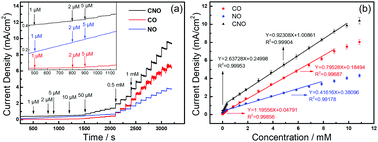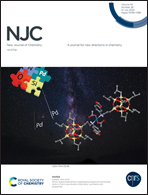The simple-preparation of Cu–Ni/CuO–NiO using solution plasma for application in a glucose enzyme-free sensor†
Abstract
The design of composite catalysts with two metals and their oxides for the detection of glucose is a particularly novel method to couple together the advantages of different kinds of metals. In this study, a simple and rapid method was used for preparing composite catalysts for use as glucose sensors. We used the solution plasma technique to synthesize a Cu–Ni/CuO–NiO precursor in an open system without any chemical additions in a shorter time. Cu–Ni/CuO–NiO catalysts derived from the subsequent heat treatment of precursors show high performance as glucose electrochemical sensors with a fast reaction time (∼1 s) and a low detection limit (54 nM). There are two linear detection ranges of 0 to 0.35 mM and 0.35 to 9.85 mM, with sensitivities of 2637.282 and 923.084 μA mM−1 cm−2, respectively. The Cu–Ni/CuO–NiO catalyst exhibits good stability (retaining 90.68% current density after 42 days) and reproducibility (relative standard deviation (RSD) = 1.72%, 3.28%). In addition, it has excellent selectivity for glucose in the presence of interfering substances. These improved performances were considered to result from the synergistic effects between the two metals and their metal oxides. Furthermore, this work provides novel insights into the development of a solution plasma method that could provide a useful approach for fabricating other highly efficient electrocatalysts.



 Please wait while we load your content...
Please wait while we load your content...